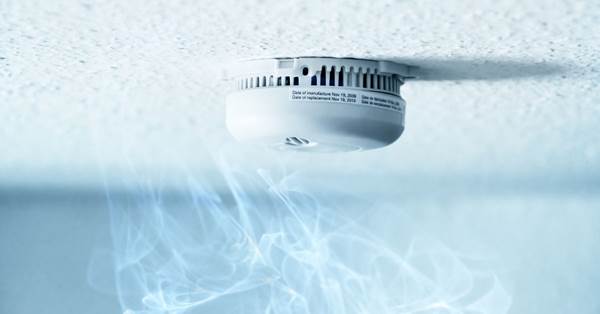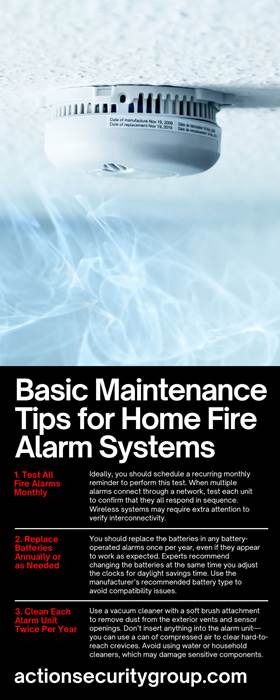6 Basic Maintenance Tips for Home Fire Alarm Systems
Stay Up To Date With Fire & Life Safety

Home fire alarm systems provide early warnings that save lives and protect property, and regular maintenance keeps these systems operating efficiently during emergencies. Many homeowners install alarms and then forget about them, assuming they’ll function perfectly when needed.
That mindset leads to unnecessary risk that can put you and your family in danger. This guide highlights six basic maintenance tips for home fire alarm systems that every homeowner should follow.
1. Test All Fire Alarms Monthly
Fire alarms need consistent monthly testing to ensure they function properly. Pressing the “test” button activates the internal siren. If the alarm sounds loud and clear, it will likely operate as expected. A weak sound or no response indicates a battery or hardware issue.
Ideally, you should schedule a recurring monthly reminder to perform this test. When multiple alarms connect through a network, test each unit to confirm that they all respond in sequence. Wireless systems may require extra attention to verify interconnectivity.
Document the test results in a notebook or digital app. This simple habit helps you maintain a consistent record, which can prove helpful during home inspections or insurance claims.
If you discover an issue during a test, replace the battery or the entire alarm unit immediately. For hardwired systems, consult your manual or a licensed electrician for replacement steps.
2. Replace Batteries Annually or as Needed
Over time, batteries will lose their charge, and dead batteries can cause alarms to fail in silence. This silent failure explains why hardwired alarms often include backup batteries to maintain operation during power outages.
You should replace the batteries in any battery-operated alarms once per year, even if they appear to work as expected. Experts recommend changing the batteries at the same time you adjust the clocks for daylight savings time. Use the manufacturer’s recommended battery type to avoid compatibility issues.
Some modern alarms use sealed lithium batteries designed to last up to 10 years. While they don’t require regular battery replacement, they still need periodic testing to ensure functionality. For traditional models, choose high-quality batteries to maximize your alarm system’s longevity and reliability.
It’s also essential to keep spare batteries stored in a dry, accessible location. When replacing batteries, clean the contact points with a dry cloth to remove corrosion or debris. Secure the battery compartment cover after installation to prevent accidental dislodging.
Never ignore a chirping alarm, as that sound indicates a low battery or malfunction. Replace the battery or entire unit immediately to avoid lapses in protection.
3. Clean Each Alarm Unit Twice Per Year
Dust, debris, and other particles can interfere with a fire alarm’s sensors, reducing its ability to detect smoke. Regular cleaning keeps your units free from these contaminants. Dirty alarms produce false alerts or fail to respond to real emergencies.
Use a vacuum cleaner with a soft brush attachment to remove dust from the exterior vents and sensor openings. Don’t insert anything into the alarm unit—you can use a can of compressed air to clear hard-to-reach crevices. Avoid using water or household cleaners, which may damage sensitive components.
Schedule biannual cleanings on the same days you replace HVAC filters or service your home’s heating and cooling system. Tie maintenance tasks together to build a consistent habit.
After cleaning, test the alarm again to verify its functionality. Cleaning doesn’t reset the alarm’s internal clock or battery status, so these checks ensure ongoing reliability. If frequent false alarms continue after cleaning, consider relocating the alarm away from kitchens, bathrooms, or HVAC vents.
4. Replace Alarms Every 10 Years
Smoke alarms degrade over time. Even when they appear functional, internal sensors lose sensitivity after a decade. The National Fire Protection Association (NFPA) and alarm manufacturers recommend replacing fire alarms every 10 years.
Locate the manufacture date printed on the back of each alarm. If the unit lacks a visible date or looks damaged, replace it immediately. When installing a new alarm, label the date of installation with a permanent marker. This habit helps you track future replacements.
Take this opportunity to evaluate your home’s fire alarm coverage. Every bedroom, hallway, and floor should have a working smoke alarm. Carbon monoxide detectors are also essential in homes with fuel-burning appliances, attached garages, or fireplaces.
Choose alarms that offer photoelectric and ionization sensing for broader detection capability. Newer models often feature long-life batteries, interconnected wireless signals, and silence buttons for temporary mute options.
Proper disposal of old alarms ensures environmental safety, as some units may contain radioactive materials or electronics that require special handling. Contact your local waste management agency for guidance on disposal.
5. Keep Fire Alarms Free From Obstructions
Fire alarms need unobstructed airflow to detect smoke effectively. Avoid placing furniture, curtains, or decorative items near alarms. A blocked sensor cannot respond quickly during a fire.
Reevaluate the placement of each alarm in your home. Alarms should be mounted on ceilings or high on walls, at least 4 inches away from corners. Keep them 10 feet from cooking appliances to reduce false alarms, and never paint over alarms or place covers on them.
Inspect alarms regularly to ensure proper visibility and clearance. Move tall furniture that blocks wall-mounted units, and don’t hang artwork or shelving directly below ceiling-mounted devices.
If you remodel your home, consult a fire safety professional to adjust alarm locations appropriately. Home layout changes often affect airflow and may require new placement for optimal performance.
6. Develop a Home Fire Escape Plan
Maintenance supports functionality, but preparation ensures an effective response. A home fire escape plan complements alarm maintenance by providing a strategy for safe evacuation.
Start by drawing a floor plan of your home and marking two exits from every room. Practice using these exits with your household. Hold fire drills twice a year, both during the day and at night, to ensure everyone responds appropriately under different conditions.
Designate a safe meeting point outside the home. Teach children how to crawl low under smoke and test doors for heat before opening them. Emphasize the importance of not re-entering the home once outside.
Combine alarm tests with fire drills to simulate real emergencies. This pairing reinforces muscle memory and builds confidence. Include guests and babysitters in your safety plan discussions, if needed.
Finally, use resources from fire departments or online safety organizations to improve your plan. Store emergency numbers in your cellphones, and place information for first responders in a central location inside your home.
Enhance Home Fire Safety With Action Security Group
Homeowners must take proactive steps to ensure the reliability of their fire alarm systems. Following these six basic maintenance tips for home fire alarm systems significantly reduces the risk of fire-related injuries and property damage.
If you’re considering additional protection for your home, professional systems can provide enhanced coverage. You can seek out home fire alarm installation in Rochester, NY, to find qualified experts in your area.
The team at Action Security Group will help you form the foundation of an effective home fire safety system. We’ll give you the tools to stay alert, organized, and take every alarm seriously.
